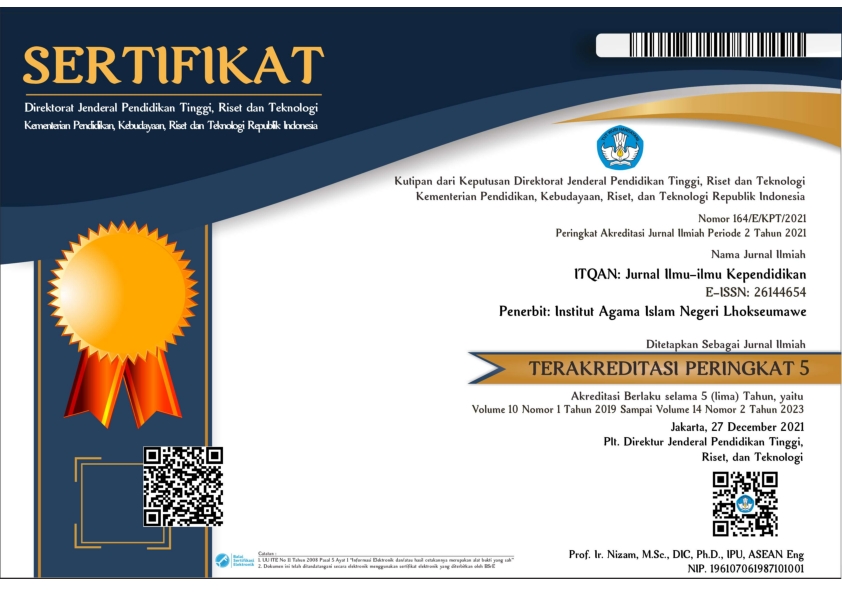Types of Euphemism in Anies Baswedan’s Speech
Main Article Content
Jumat Barus
Euphemisms are often used in language activities to subtly convey sensitive information. Careful word choice allows one to avoid using vulgar or unpleasant language that may offend others. This study aims to explain the types of euphemisms used by Anies Baswedan in his statement after the announcement of his candidacy as Indonesia's presidential candidate in the 2024 election by the Nasdem Party. Allan and Burridge's framework in categorizing the types of euphemisms becomes the theoretical basis in this research. This research uses a qualitative approach with a content analysis method, by analyzing words, phrases, or sentences containing euphemism components found in Anies Baswedan's speech on 4 October 2022, sourced from metro.tempo.co. The analysis reveals four main types of euphemisms: 11 instances of metaphor (32.35%), 6 cases of one-for-one substitution (17.65%), 16 occurrences of circumlocution (47.06%), and 1 instance of figurative expression (2.94%). These forms of euphemism are used as alternative linguistic expressions, softening the language to prevent the use of sensitive or vulgar expressions that can offend others.
Allan, Keith and Burridge. (1991). Euphemism & Dysphemism Language Used as Shield and Weapon. Oxford: Oxford University.
Allan, Keith and Burridge, Kate. (2006). Forbidden Words: Taboo and the Censoring of Language. Cambridge: Cambridge University Press.
Allan, K., Burridge, K., Crespo- fernández, E., & Jamet, D. (2020). Euphemism as a Word-Formation Process. (June 2012), 0–200. https://doi.org/10.4000/lexis.334.
Allan, K., & Utama, B. (n.d.). Euphemism and Language Change: The Sixth and Seventh Ages. Université Jean Moulin - Lyon 3.URL:http://journals.openedition.or g/lexis/355.
Bachriani., Yassi, A. H., & Rahman, F. (2018). A comparative study of euphemism in English and Buginese: Pragmatic stylistics contexts. ELS Journal of Interdisciplinary Studies in Humanities, 1(4). http://journal.unhas.ac.id/index.php/jish.
Barus, Jumat. (2020) Taboo Avoidances in Karo Language. Language Literacy: Journal of Linguistics, Literature, and Language Teaching Vol. 4(1), pp. 101-111. DOI: https://doi.org/10.30743/ll.v4i1.2453.
Burridge, Kate. 2012. “Euphemism and Language Change: The Sixth and Seventh Ages”. Lexis 2012.
Busetto, L. (2020). How to Use and Asses Qualitative Research Methods. BMC. https://neurolrespract.biomedcentral.com/articles/10.1186/s42466-020-00059-z.
Haryati, H. (2020). The Study of Taboo and Euphemism on the English Department Students in Universitas Pamulang. Lire Journal (Journal of Linguistics and Literature), 4(1), 92-111. https://doi.org/10.33019/lire.v4i1.60.
Jaganegara, H., Arvian, E., & Noryatin, Y. (2020). Euphemism types in the Washington Times Online Political Articles: A Study of Semantic Change. LADU: Journal of Languages and Education, 1(1), 11–19. https://doi.org/10.56724/ladu.v1i1.3.
Korneeva, A., Kosacheva, T., Parpura, O. (2019). Functions of Language in the Social Context. SHS Web of Conference, 69. OI:10.1051/shsconf/20196900064.
Moleong, L. J. (2018). Metodologi Penelitian Kualitatif. Bandung: Remaja Dharma.
Nazar, M. (2022). The Contribution of Metaphor to Islamic Education Learning. ITQAN: Jurnal Ilmu-Ilmu Kependidikan, 13(1), 89-102. https://doi.org/10.47766/itqan.v13i1.286.
Noermanzah, (2019). Bahasa sebagai Alat Komunikasi, Citra Pikiran, dan Kepribadian.
Nusri, Try Putera and Mubarak, Zia Hisni. (2022). The Types of Euphemism Used in the Headline News by Tempo.Co 2022. Journal Basis. Vol. 9(2) 2022. Doi: https://doi.org/10.33884/basisupb.v9i2.6118.
Poole, S. C. (1999). An Introduction to Linguistics. London: Macmillan.
Rawson, H. (1981). A Dictionary of Euphemisms and Other Doubletalk. New York: Crown Publishers, Inc.
Sani, Ahmad Faiz Ibnu. (2022). Pidato Lengkap Anies di NasDem: Demokrasi, Pembangunan, dan Peribahasa Aceh. https://metro.tempo.co/read/1641367/pidato-lengkap-anies-di-nasdem-demokrasi-pembangunan-dan-peribahasa-aceh.
Saussure, F. de. (1988). Pengantar Linguistik Umum. Yogyakarta: Gadjah Mada University.
Serli, Y., Wahyuni, D., & Padang, U. N. (2018). An Analysis of Euphemism in Crimes and Politics News. E- Journal of English Language and Literature Volume 7 No. 4 http://ejournal.unp.ac.id/index.php/je l.
Shalihah, M., and Zuhdi, M. N. (2020). Language Politeness in Students’ Text Messages Sent to the Lecturers through WhatsApp Application: a Sociopragmatic Study. EnJurMe (English Journal of Merdeka), 4(2).
Shaunaa, R., Chojimah, N., & Sugiharyanti, E. (2022). Euphemism Used by Donald Trump and Hillary Clinton in the 2016 Political Debate. Journey: Journal of English Language and Pedagogy, 5(2), 182–190. https://doi.org/10.33503/journey.v5i2.1947.
Suhadi, J., Manugeren, M., Purwarno, P., Siwi, P., & Ekalestari, S. (2021). Functions of Euphemism in Putu Wijaya’s Short Story Guru. English Review: Journal of English Education, 10(1), pp. 27-36. doi: https://doi.org/10.25134/erjee.v10i1.5351.
Tuerah, Javier. (2021). Euphemism in CNN Online Newspaper. Kompetensi: Jurnal Ilmiah Bahasa dan Seni. Vol. 1(9) 2021.
Wardhaugh, Ronald. (2010). An Introduction to Sociolinguistics 6th Ed. Oxford: Wiley- Blackwell.




